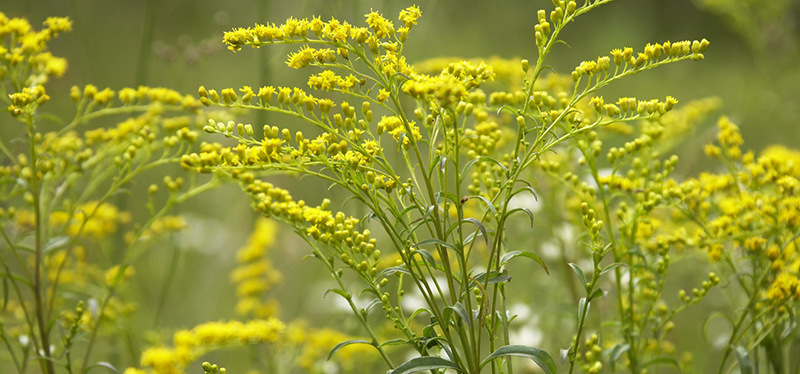Month-By-Month Guide to Allergies

Which allergy trigger is making you sneeze? It depends on the month and season. Here's a month-by-month guide of allergy triggers so you can learn more.
Allergies aren’t just a spring affair. They can strike at any time of year. But the culprit behind your sneezes and sniffles can change, depending on the season. Here’s a guide to the most common allergy triggers, month-by-month, to help you root out the cause of your symptoms.
YOU MIGHT ALSO LIKE: The Difference Between Spring and Fall Allergies
September
An explosion of ragweed ushers in the fall. Mid-September is peak season for this weed, which grows in just about every state. A ragweed plant can shoot as many as 1 billion pollen grains into the air, and those grains can leave a path of allergy misery hundreds of miles in each direction. Unfortunately for anyone allergic to ragweed, its pollen can stick around until the first frost.
October
Fall is also peak season for mold, an indoor allergen that grows in damp places. Mold is a fungus that releases spores. Breathing in those spores sets off allergy symptoms in people who are sensitive to them. To prevent mold from gathering in shower stalls and basements, keep the humidity in your home low.
Once you have mold, it can be hard to get rid of, says Andrew Singer, MD, clinical instructor at the University of Michigan Medical School. “I think first and foremost, you should make sure you eliminate the source of the water, fix any leaky pipes, and keep the internal environment as dry as you can. Then you should use a bleach solution to clean the obvious mold that you see,” he advises.
November
As fall winds to a close, ragweed season also prepares to make its exit. Anyone with outdoor allergies can start to enjoy a reprieve as pollen levels decline. Yet indoors, mold will continue to be an issue throughout the winter months.
December
Although the first snowflakes might be falling and the holidays are right around the corner, allergies don’t take a vacation.
“During the winter, families spend more time indoors, exposing allergic individuals to allergens and irritants like dust mites, pet dander, smoke, household sprays and chemicals, and gas fumes — any of which can make their lives miserable,” says William Reisacher, MD, director of the Allergy Center in the Department of Otolaryngology (Ear, Nose, and Throat) at NewYork-Presbyterian Hospital/Weill Cornell Medical Center.
Christmas trees, wreaths, and other festive decorations can carry dust and mold into your home if you don’t clean them well first.
January
As the cold weather drives people indoors, indoor allergens become more of an issue. Spending more time in your home increases your exposure to mold, dust, and pet dander. Winter allergies can be every bit as miserable as their spring counterparts. Keeping home humidity levels below 40 percent and washing bedding and pets often can reduce allergy exposures.
February
Indoor allergens like mold, dust, and pet dander continue to be a problem in February, but at this time of year you might mistake your stuffed, runny nose for a cold. How do you tell the difference? A cold will have other symptoms, like a sore throat or fever, and should dissipate within a couple of days, while allergies will stick around longer.
March
Winter is drawing to a close, and in some parts of the country the first buds of spring are starting to appear. At this time of year, tree pollen will start to become a problem for spring allergy sufferers. Now is the time to start keeping an eye on your local pollen count.
April
“Airborne allergens, including those from tree, grass, or ragweed, often spike this time of the year,” said Anju Peters, MD, an allergist at Northwestern Medicine.
Pollens from birch, cedar, walnut, sycamore, cottonwood, oak, and pine trees are particularly prevalent. Keeping your windows shut and your air conditioner on can prevent pollen from invading your home.
May
Tree and grass pollen counts are both high at this time of year, a double dose of misery that may drive allergy sufferers indoors. While tree pollens will start to recede in some parts of the country by the end of this month, grass pollen is heading into its peak season.
June
Warmer temperatures and sunny days may lure you outdoors but, if you’re allergic to grass pollen, you might want to adjust your excursion times. Grass pollen counts peak during the mid- and late-afternoon hours.
July
Grass pollens continue to be a problem, along with mold spores, which peak this month. The hot, humid weather leads to a burst of new mold growth — especially on dry leaves, dead grass, and plants.
August
August brings the unwelcome return of ragweed, which starts its season this month. Other weeds, like pigweed, cocklebur, Mugwort, and Goldenrod, also become plentiful as the summer starts to recede into fall.
Updated:
September 01, 2023
Reviewed By:
Janet O’Dell, RN